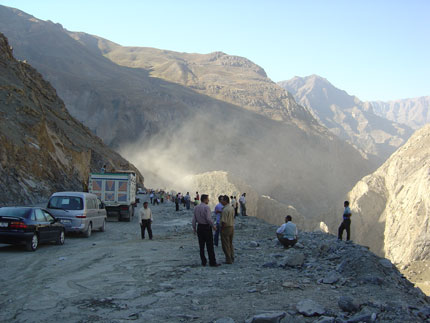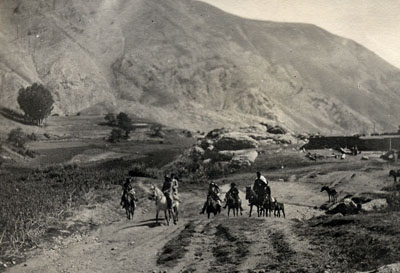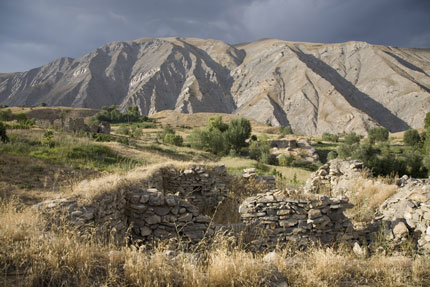|
 Building the new road to Hakkari town - Summer 2007
Hakkari is a hardly accessible region with high mountains and remote valleys in eastern Turkey, to the south of Lake Van. Embedded in its broad and deep gorge, the Great Zab river flows from north to south through these rugged mountains. Up to 1915, the year of the Armenian genocide which swept away the Christian minority in the Ottoman Empire, Hakkari was the homeland of the Assyrian tribes. These mountaineers were Nestorian Christians.
The Assyrian mountaineers lived in villages on the slopes above the Zab river and in settlements well-hidden in side valleys. As tribal or ashiret people ruled by their own local chieftains, the maliks, they were subdivided into large clans that occupied their own part of the territory. The Tyari tribe was the most important one, with almost half of the Assyrian population. Other tribes were known as Tkhuma, Baz, Diz and Jelu.
The leader of the Assyrian mountaineers was their patriarch Mar Shimun, whose title and authority had become hereditary within one family. He had its residence in Qodshanes, a Nestorian village on an isolated plateau, deep in the heart of the Hakkari mountains.
In those days, till the beginning of the 20th century, Ottoman Turkish rule in Hakkari was limited to formal jurisdiction - collecting tribute from the Assyrian mountain villages was the privillege of patriarch Mar Shimun. On the other hand the Christian Assyrians were surrounded by Muslim neighbours - Kurdish tribes - with whom the Assyrians lived to some extent in good harmony, till some local feud led once more to an armed conflict.
It is all history now. After the First World War the mountain villages of the Assyrian tribes were ruined places, deserted by their original inhabitants who had fled to Persia and from there to Iraq under British protection. Patriarch Mar Shimun was brutally assassinated in 1918 by the Kurdish chieftain Agha Ismail Simko, who trapped the Assyrian patriarch during so-called negotiations close to Salmas, NW Persia, when Simko treacherously proposed to unite the Assyrian warriors and his own Kurdish tribesmen against the Turkish army.
The old name of the main town in the Hakkari mountains was Julamerk. Later on, still in the 19th century, the name was changed to Hakkari, when the predominant tribe of the Hakkari Kurds controlled the area. Nowadays the capital of this Turkish province in the mountains of SE Turkey is still called Hakkari. It is a booming town, 1.700 metres above sea level, and booming refers here to its strategic position. Turkish soldiers wander through the inner city, Turkish officers and their families live in separate housing units around the town centre. Hakkari town has become a military stronghold of the Turkish army in its campaign against the Kurdish PKK guerrilla in the Hakkari mountains.
A modern army, operating in heavily armed armoured cars, needs modern roads. That is why a new broad asphalt road cuts its way through the Hakkari mountains, from Van in the north to Hakkari town and then following the gorge and running south along the Zab river towards the Iraqi border. Hakkari town is only a few miles away from that military highway. The last old mountain track, from the turn to the town, is now being broadened and levelled.
 Nestorian Patriarch Mar Shimun riding with servants - Qodshanes 1904
Qodshanes, once the dwelling place of the Assyrian patriarch Mar Shimun, is situated to the north of Hakkari town. But even today there is no decent road leading to that deserted historical site where a hundred years ago Assyrian mountaineers gathered in the residence, the kelaita or community house of patriarch Mar Shimun, and worshipped in the age-old Nestorian Mar Shalita church.
 Ruins of Assyrian Qodshanes in the high mountains of Hakkari - Summer 2007
Text & illustrations - August Thiry & Geert Segers
|

 Homeland
Homeland  Turkey
Turkey  Hakkari
Hakkari

 Homeland
Homeland  Turkey
Turkey  Hakkari
Hakkari